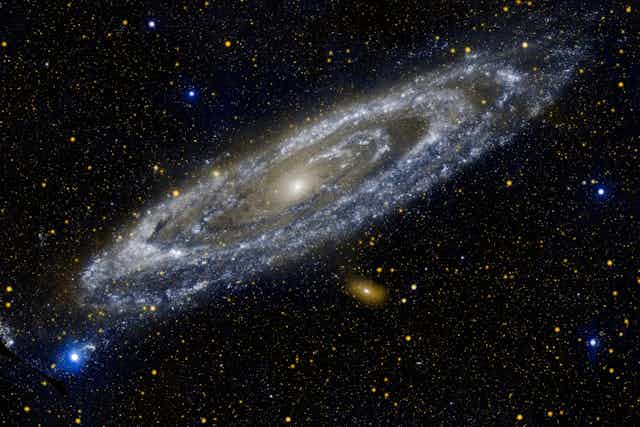How did large galaxies, like our own Milky Way and the nearby Andromeda Galaxy, emerge from the featureless soup that existed after the birth of our universe?
Decades of observations and theoretical effort have provided a picture in which atoms pool into galaxies, drawn by the gravitational pull of dark matter. Our synthetic universes, created and evolved on the most powerful supercomputers, beautifully match the distribution of galaxies we see on the universe.
Understanding the small-scale detail is going to occupy astronomers for decades to come, but it appears that galaxies are built up over time by accreting (gathering) smaller systems that stray too close.
And in the past few decades, it has become clear that the tenuous stellar halo that surrounds large galaxies holds the clues to unravelling galaxies accretion history.
Dissecting galaxies
A big spiral galaxy can be split into three key pieces: the bulge, the disk and the halo.
The bulge and disk are home to the vast majority of the hundreds of billions of stars that make up the galaxy, whereas only 1% of the stars can be found in the halo that envelopes a galaxy.

The halo hosts some of the oldest stars to be found in a galaxy. It is also home to globular clusters, the oldest bound groups of stars we know in the universe.
These suggest that the halo was the first galactic component to form, and it should hold some of the best preserved record for the formation history of a galaxy.
But to reveal the secrets hidden within a galaxy, astronomers have to take a forensic approach and look at the stellar halo like a crime scene.
Galactic cannibals
It is within the stellar halo that smaller dwarf galaxies meet their ultimate fate, losing their battle with the destructive forces of gravity.
These dwarf galaxies are stripped, harassed and dispersed until they eventually mix with the stars of the larger galaxy.
But this destruction, this galactic cannibalism, can take many billions of years, and we expect to catch the ongoing destruction of dwarf galaxies even today.

There is observational evidence for the existence of a range of substructures in galaxy halos, such as tidal streams and stellar shells, revealed in our own Milky Way and the neighbouring Andromeda Galaxy.
It is within these galaxies that we can identify and isolate individual stars within the extremely faint halo. And it was the halo of Andromeda that formed the focus for our new study published recently.
A search for clustering
Instead of stars, we used a map of the planetary nebulae that also inhabit the halo of Andromeda.
These are the late-stage evolution of stars similar to our own sun, stars that are the debris of disrupting and disrupted dwarf galaxies. Luckily, these are readily identifiable due to their peculiar spectral signature, a signature that also reveals their velocities.
We needed to pick over these galactic corpses, dissecting the crime scene to work out just how many victims lay hidden in plain sight.
To do this, we looked for how “clustered” these planetary nebulae are.
If the picture of halos growing through accretion is correct, then we should expect an underlying smooth and unclustered distribution, the remnants of ancients accretions that have been completely disrupted and mixed, overlaid with ongoing accretions that should be clustered together in space and velocity.

But there are problems. While we can see where the planetary nebulae are in the sky, and we can measure the velocity along the line-of-sight, distances are unknown, as are the proper motions in the plane of the sky.
We had to develop some clever methods to search for clustering signatures, and compare these to expectations drawn from synthetic models of galaxies.
And success! The results revealed a mix of smoothly scrambled and lumpy clustered planetary nebulae, precisely in accordance with our cosmological expectations.
This provides further evidence for our current best explanation for the cosmos, the Lambda Cold Dark Matter cosmological model, a universe dominated by the gravitational pull of dark matter battling the expansion of the universe, and where galaxies have been steadily built up over time through devouring smaller systems.
While this success is heartening, with growing evidence that our understanding of the workings of the universe is well founded, tensions remain. This is particularly so on the scale of individual halos of large galaxies – the recently discovered coordinated dance of dwarf galaxies still cries out for an answer.
Astronomical effort will continue over the next few decades, but on the question of when we will truly understand galaxy formation and evolution, the jury is still out.

